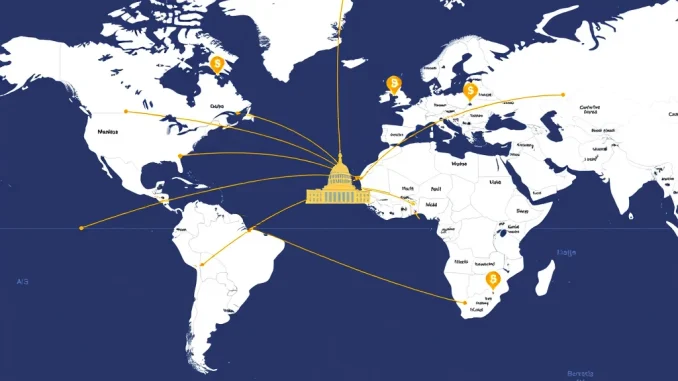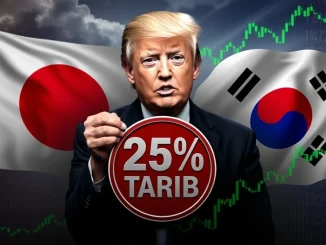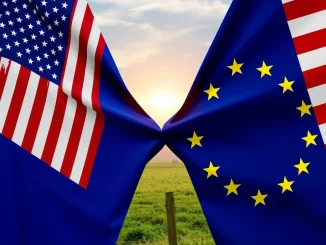
In a revealing statement that has sent ripples through global economic circles, U.S. Treasury Secretary Scott Besant has clarified the driving force behind the ongoing tariff talks. Forget market speculation; the Secretary emphasized that these discussions are predominantly fueled by an overwhelming wave of international requests, underscoring the significance of global outreach in shaping trade policy. For those in the cryptocurrency sphere, understanding these macroeconomic shifts is crucial as they indirectly influence market sentiment and regulatory landscapes. Let’s delve into what this means and why it matters.
Decoding the US Treasury’s Tariff Talks and Global Outreach
Tariff talks are essentially negotiations between countries regarding taxes or duties imposed on imported or exported goods. These discussions are pivotal in shaping international trade relations and can have far-reaching economic consequences. The traditional understanding is that market forces, such as supply and demand, and economic indicators, primarily dictate the initiation and direction of these talks. However, Secretary Besant’s statement throws a curveball, highlighting a different catalyst: global outreach. But what exactly does this mean?
According to Jinse Finance’s report, Secretary Besant pointed out that a staggering number – up to 70 countries – have proactively reached out, requesting negotiations. This volume of direct requests suggests a global eagerness to engage with the U.S. on trade matters, driven by factors beyond immediate market pressures. It signals a more complex interplay of geopolitical strategies, diplomatic initiatives, and long-term economic planning at play.
Here’s a breakdown of why this emphasis on global outreach is noteworthy:
- Proactive Engagement: The fact that so many nations are initiating these talks indicates a proactive approach to international trade, rather than reactive measures to market fluctuations.
- Beyond Immediate Economics: It suggests that countries are considering broader strategic and diplomatic goals in their trade policies, beyond just short-term economic gains or losses driven by market forces.
- Geopolitical Significance: This high level of engagement underscores the U.S.’s central role in global trade and the desire of numerous nations to establish or refine their trade relationships with the world’s largest economy.
US Treasury’s Focus: Shifting Away from Market Forces?
Secretary Besant’s assertion that these tariff talks are driven by requests, not solely by market forces, is a critical distinction. While market dynamics undoubtedly play a role in trade policy, this statement suggests a more nuanced approach. It implies that the U.S. Treasury is prioritizing diplomatic engagement and responding to international calls for dialogue as a primary driver for these negotiations.
Consider this comparison:
| Factor | Market-Driven Tariff Talks | Outreach-Driven Tariff Talks |
|---|---|---|
| Primary Catalyst | Fluctuations in supply, demand, trade deficits, economic indicators | Direct requests from nations for negotiation |
| Focus | Addressing immediate economic imbalances, correcting trade disparities | Building and maintaining international relationships, strategic alliances, long-term trade frameworks |
| Approach | Reactive to economic data and market signals | Proactive diplomatic engagement and response to global partners |
| Example Scenario | Imposing tariffs due to a surge in imports in a specific sector | Initiating talks based on a formal request from a country seeking better trade terms |
This shift in emphasis doesn’t negate the importance of market forces, but it does highlight a more diplomatic and internationally collaborative approach to trade policy under the current U.S. Treasury. It signals a willingness to engage with global partners on their terms, addressing their concerns and requests proactively.
Cryptocurrency Regulations and the Ripple Effect of Global Trade Discussions
Now, how does this all tie back to the world of cryptocurrency and cryptocurrency regulations? While tariff talks may seem distant from the digital asset realm, the interconnectedness of the global economy means that shifts in trade policy can have indirect yet significant consequences. Here’s how:
- Economic Stability and Investor Sentiment: Global trade tensions and agreements directly impact overall economic stability. Uncertainty in trade relationships can lead to market volatility, influencing investor sentiment across all asset classes, including cryptocurrencies. Positive trade developments can foster a more optimistic economic outlook, potentially boosting investor confidence in risk-on assets like crypto.
- Regulatory Landscape: International cooperation on trade often involves discussions on regulatory harmonization. While not directly about cryptocurrency regulations, these broader dialogues can set precedents and create frameworks for international regulatory collaboration in other sectors, potentially influencing future approaches to crypto regulation.
- Cross-Border Transactions and Digital Economy: Tariff talks and trade agreements increasingly touch upon the digital economy and cross-border data flows. As cryptocurrencies are inherently global and facilitate cross-border transactions, the outcomes of these trade discussions can indirectly shape the environment for digital assets and their international movement.
- Inflation and Monetary Policy: Tariffs can contribute to inflationary pressures, which in turn can influence central bank monetary policies. These policies, such as interest rate adjustments, can have a direct impact on the attractiveness of cryptocurrencies as alternative assets.
Navigating the Evolving Landscape: Actionable Insights
Understanding that tariff talks are being driven by global outreach, and not just immediate market forces, offers a valuable perspective. For those involved in cryptocurrency, staying informed about these broader economic and geopolitical developments is essential. Here are some actionable insights:
- Stay Informed: Keep abreast of news related to international trade, tariff discussions, and statements from bodies like the U.S. Treasury. Financial news outlets and economic analysis reports are crucial resources.
- Consider Macroeconomic Factors: When making investment decisions in cryptocurrency, factor in the broader macroeconomic environment, including global trade policies and their potential impacts.
- Diversify Your Information Sources: Don’t rely solely on cryptocurrency-specific news. Broaden your information intake to include global economic news and analysis to get a holistic view.
- Understand Indirect Impacts: Recognize that global trade policies and US Treasury decisions, even if seemingly unrelated to crypto, can create ripple effects that influence the cryptocurrency market indirectly.
Conclusion: A New Era of Global Trade Engagement
Secretary Besant’s clarification that tariff talks are significantly influenced by global outreach rather than solely by market forces marks a noteworthy shift in understanding international trade dynamics. It underscores a proactive, diplomatic approach by the US Treasury in engaging with global partners. For the cryptocurrency community, this highlights the importance of looking beyond immediate market trends and appreciating the broader macroeconomic and geopolitical landscape. As global trade policies evolve, their indirect influence on the digital asset space will continue to be a factor to watch closely. Staying informed and understanding these interconnected dynamics is key to navigating the complex and ever-changing world of cryptocurrency and global finance.



